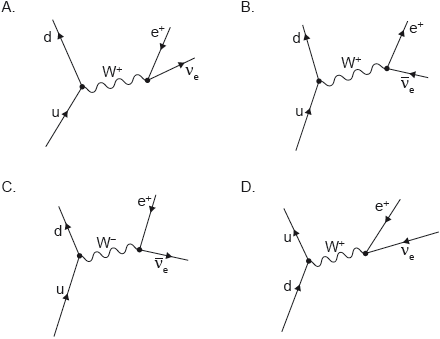| Date | May 2022 | Marks available | 2 | Reference code | 22M.2.SL.TZ1.5 |
| Level | Standard level | Paper | Paper 2 | Time zone | 1 |
| Command term | Describe | Question number | 5 | Adapted from | N/A |
Question
Describe the quark structure of a baryon.
The Feynman diagram shows a possible decay of the K+ meson.
Identify the interactions that are involved at points A and B in this decay.
The K+ meson can decay as
K+ → μ+ + vμ.
State and explain the interaction that is responsible for this decay.
Markscheme
3 quarks / example with three quarks «e.g. up up down» ✓
integer / zero / 1 / no fractional «electron» charge
OR
held together by the strong force / gluons
OR
half integer spin
OR
baryon number = 1
OR
colour neutral ✓
A «Decay of the strange antiquark is a» weak «interaction» ✓
B «Decay of the u to a gluon and eventually to d and anti-d is a» strong «interaction» ✓
weak «interaction» ✓
strangeness is not conserved and this is possible only in weak interactions
OR
the weak interaction allows change of quark flavour
OR
only the weak interaction has a boson / an exchange particle / a W+ to conserve the charge
OR
neutrinos are only produced via the weak interaction ✓
Examiners report
A significant number of candidates recognized that baryons are composed of three quarks. The second mark was for a statement concerning baryons as a result of the quark composition, and not for a general statement about the quarks (e.g. "the baryon number is 1" rather than "each quark has a baryon number of ⅓). It is worth noting that the information about individual quarks is given in the data booklet which is why no marks were awarded for simply copying this information over.
Many candidates were able to successfully identify the two interactions in the diagram. Some candidates only described what was happening in the diagram without identifying the actual interaction. A common mistake was identifying the gluon at B as a graviton, and/or suggesting that this was a gravitational interaction. Many candidates also did not make the connection between the term "interaction" in the stem and the concept of force.
This was another item where some candidates simply described the particles without specifying the weak interaction. The second marking point was for a justification based on an aspect of this decay that could only be true of the weak nuclear force. A commonly incorrect answer was that this was the only force that acted on quarks and leptons, which was not accepted due to the fact that the gravitational force also acts on these particles as well. Another common incorrect answer among SL candidates was to assume that this was an example of beta negative decay due to the presence of a neutrino.


